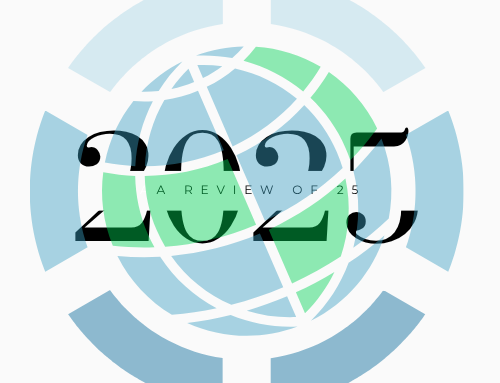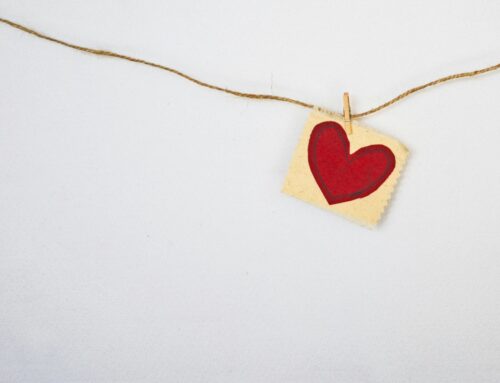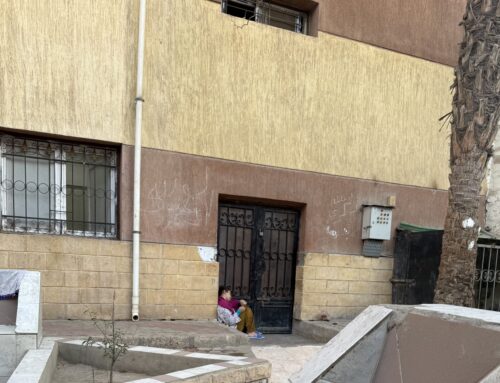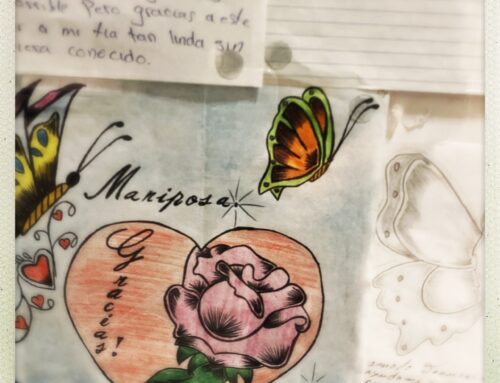The Boulder County Marshall Fire, which sparked on December 30, 2021 after an abnormally dry early winter, took two human lives, killed more than 1000 pets, and destroyed over 1000 homes in Louisville and Superior, Colorado. The conflagration vaporized photo albums, family diamonds, bronze sculptures, just-opened Christmas gifts, the cork saved from one’s wedding.
Staff at the Louisville Historical Museum initiated the Marshall Fire Story Project immediately after the fire. Since fall 2022, your team—three cultural anthropologists and the Museum’s community historians—has constituted a space for listening.
The consent script read at the start of each story sharing session is straightforward. Some of the language would be familiar to anyone involved with human subjects research: rights as a participant, how data will be stored and shared, freedom to withdraw consent at any time. But this isn’t research—there are no research questions. The opening language is inviting, careful.

Anna Kramer, Lucas Rozell, and Emily Reynolds, in a story session at the Louisville Public Library. Photograph by Kathryn E. Goldfarb.
Sitting across the table from your interviewee, you explain: “We’ve created this space as a place where our community can come together to share our collective stories of the Marshall Fire, and together build a space in which we can connect and begin to heal as a community. We understand that it may be difficult at times to share your story or hear others tell theirs. Please take care of yourself as you need to during our time together, and especially afterwards as well.”
All stories are welcome here, even those who feel they have not had sufficient losses, have not been sufficiently damaged, for their stories to “matter” in the ways their neighbors’ stories matter.
***
The first time you cry during an interview, you are momentarily embarrassed. Aren’t you meant to be the passive observer? The blank slate for your interviewee to paint their words upon? But no fury rains down as the tears roll down your face. The interviewee does not rise from her seat and leave. She has been vulnerable with you and your team already. Is it not only appropriate to share in her grief?
***
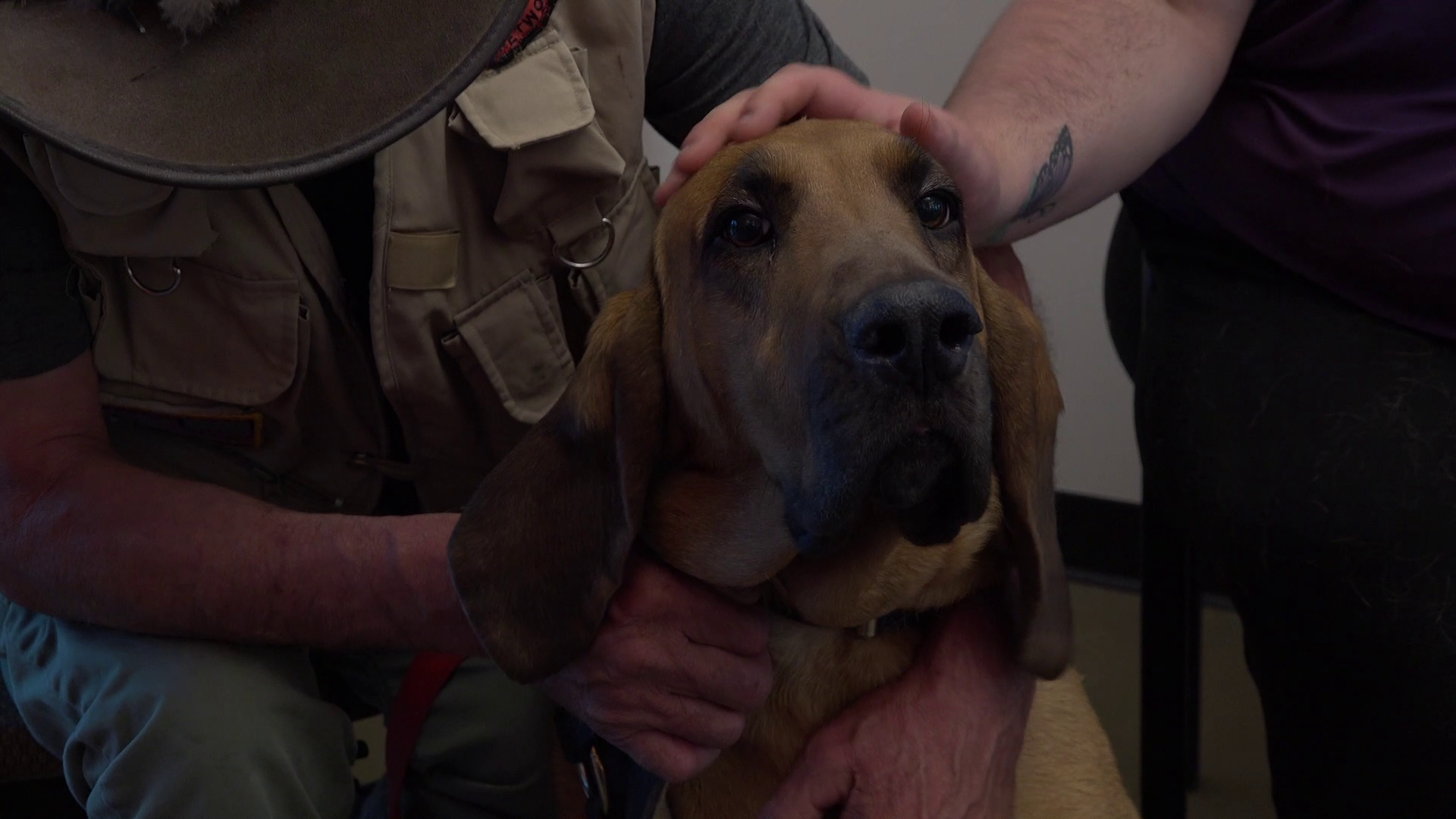
Amber the bloodhound. Photograph courtesy of the Louisville Historical Museum.
The first interview that makes you feel well and truly sick is one that you did not conduct, but merely listened to after the fact. There is a lot of this sort of work, the mundane tasks of audio editing, fixing transcription errors. When you open this file, one of the few interviews documented on video, you are momentarily delighted. There’s a dog! Why is there a dog? A service dog, perhaps? Or maybe emotional support for the interview to come?
She is a bloodhound. More than that, she is an interview participant. She works in search and rescue, alongside her handler, Duffy, who sits next to her during the interview. Amber the bloodhound was trained to search for pets, either following the trail they left when they escaped the flames, or identifying the place where they died. Duffy tells a story of a family with two golden retrievers. Amber was able to identify the place where the dogs had died in the burned-out shell of the property. And there, in that very spot, was a small metal sign—a sign that had not belonged to the family, a sign not from that house—engraved with the word “love,” positioned in the space between where the dogs must have been lying together. On camera, Duffy recalls how he had told the owners, “Maybe it’s a message from something, someone or something, telling you the dogs are saying goodbye in their own way.”
You hit pause on the recording with such force it’s a wonder your spacebar doesn’t break.
***
The transcription software your team uses to process interviews can’t make sense of the names “McCaslin” or “Via Appia.” Admittedly, neither can you. These words appear over and over in the interviews and you listen, over and over, trying to discern the meaning.
Street names, you realize one afternoon. Of course these are street names. You’re not originally from this area, and it is a revelation. Scattered across the stories, these names are reference points, former addresses, escape routes—precious geographies, for those who can recognize them.
These are names worth making intelligible. Instead of turning right to go home after an interview, you turn left onto South Boulder Road. Left again onto Via Appia Way. Right onto McCaslin Boulevard.
You drive in silence. Tucked behind the strip malls and apartment complexes are once-smoldering subdivisions and the skeletal frames of new structures. Dillon Road, South Boulder Road, Via Appia. You’re choking, although there is no heavy smoke today.
You keep driving, eventually exiting onto the highway to head home.
***
This is the most important work you’ve ever done as an anthropologist, your spouse says. At home with your family, while your daughter watches her tablet after dinner and the cats loaf by your feet, you relay the story you heard that day, an artist who managed to get her own dogs out of her house and could not stop crying as she mourned her neighbor’s dogs, whom she was unable to save.
Your spouse cuts you off. No stories about pets.
***
There’s only so much of other people’s loss and heartache that you can take in and shelter before it all starts to flow back out again. Alone, waiting hours for enormous audio files to upload, transfer, download on the crappy library WIFI, there is plenty of time for you to hover a golf pencil over a scrap of paper and turn on the tap. With no eraser and an all-but-empty progress bar, you write.
Here’s one.
The Feast
I’m gorging myself on heaping
Spoonfuls of your sorrows
Choking it down, that bitter,
Sticking gob, too cold to fuel us
It’s more than you can stomach
On your own, so I politely
Ask for more, lick the plate clean too
Anything else? I ask and you
Shake your head, but I spot the leftovers
Stashed in your purse,
And steal a taste
Your load is lighter on the way home
And my stomach has turned but
Will not empty
I drive home in silence
Thinking only of you
***
It is early winter 2025. You are woken at 1am by wind that slams and moans around the house. As a child growing up in Boulder, you had liked the sound of the nighttime wind, the inside cozier for the fury outside. But for three years now, wind has meant fire. At this moment, uncontained fires are raging in Los Angeles.
Lying in bed you remember someone who recently posted on the Marshall Fire Community Facebook page. They wrote, “Anyone else feeling incredibly grateful snow fell on 12/31/21? There is no snow for LA, ever.” The first person to reply wrote, “No. The snow was a day late.”
The Los Angeles fires dwarf the losses of the Marshall Fire. GoFundMe pages proliferate once more on your social media feeds. (You remember some findings out of the University of Colorado (CU) Boulder after the Marshall Fire, showing that the wealthier the person, the better their GoFundMes did.) There is intense energy around the sharing of hard-won expertise. Community members impacted by the Marshall Fire rally their resources, produce an expansive Google Doc for people in Los Angeles who have lost their homes—how to apply to FEMA (the Federal Emergency Management Agency), obtaining destroyed documents, “know your rights” guidelines for people catastrophically under-insured. Scientists at CU Boulder produce a “best practices” resource page for people grappling with indoor smoke damage, information that did not exist three years ago. Reporters mine the Marshall Fire Community page, asking impacted individuals to share their accounts in connection to this newest tragedy.
A few weeks later, the news cycle moves on.
Then, later, the fires are finally out.
***
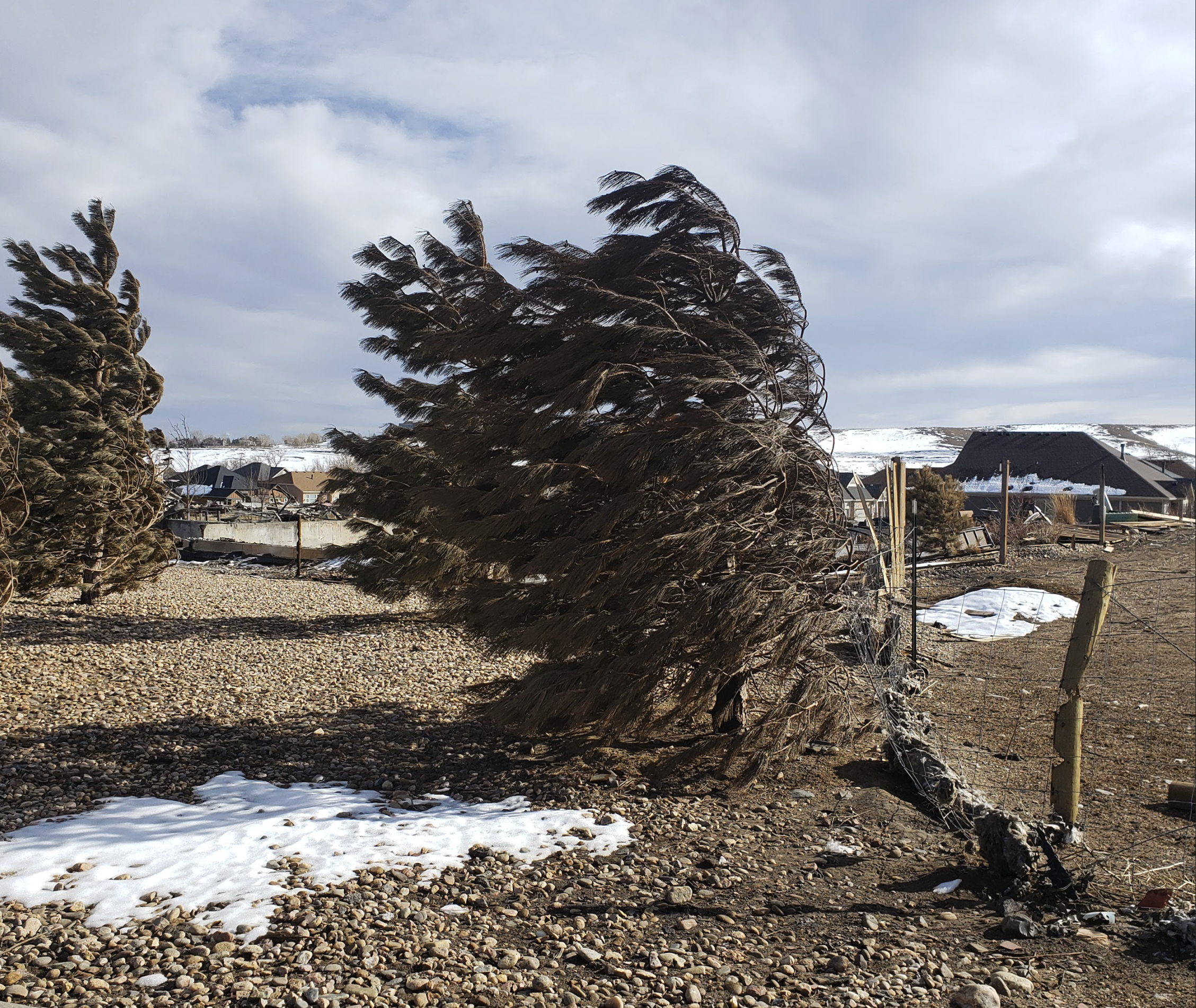
Trees frozen in place after the winds from the Marshall Fire. Photo courtesy of Anna Kramer.
One time you read a thing about how doctors assure patients that the x-ray machine is perfectly safe but then run to hide in the next room before turning it on. It’s safe to be exposed to the radiation once, but how many x-rays does the doctor give in a day? It’s safe for the participant to share their story—cathartic, even, or so the team hopes—but how many tales of loss do you hear over these months and years? Where can you put those feelings, after the story session is done and the mp3 file is safely downloaded?
What good do stories do, anyway?
The Marshall Fire Story Project is a “living archive.” The team describes this work as a community history resource, a project to document accounts that would otherwise be lost: stories that may one day be learned from, studied by policy makers, climate change scholars, anthropologists, perhaps, researching the narration of trauma and disaster.
You, yourself are now also a living archive. The stories you have heard live in you, play back against closed and open eyes.
The wind blowing with such ferocity that a woman, blinded by smoke and ash, trying to escape, can’t even open the car door. Much later, after she has gotten out of her burning neighborhood, she realizes that she somehow left her purse in the driveway. You imagine how she would have needed both hands to wrench open the car door. The guy with the kids, hustling them into the car as he wonders whether the towering pine next to their driveway will give way before they can get out. The person who off-roaded past a line of cars and onto South Boulder Road the wrong direction. These are a genre of story—evacuation stories—and there are many, because community members and firefighters pounded on so many doors. Almost everyone escaped.
You hold the story of the woman who, the night before the fire, somehow knew her beloved fish were trying to tell her goodbye, that they wouldn’t be seeing her again. The story of the child who, after the fire, made drawing after drawing of her family’s house—but with wings, so it could fly away.
The archive of your body, holding these stories. A sort of “intercorporeal generosity” (Diprose 2002), perhaps? A distribution of responsibility? A kind of accountability?
References
Diprose, Rosalyn. 2002. Corporeal Generosity: On Giving with Nietzsche, Merleau-Ponty, and Levinas. The State University of New York Press.
Acknowledgements
Thank you to Jason Hogstad, Sophia Imperioli, and Gigi Yang of the Louisville Historical Museum. We are grateful to the University of Colorado Boulder Studio Program for Undergraduate Research and the Office for Public and Community-Engaged Scholarship for supporting the Marshall Fire Story Project.
Lucas Rozell is a qualitative and mixed methods researcher at the University of Colorado Anschutz Medical Campus. Their work focuses on bioethics and disability justice, with special attention to the ways that environment and lived experiences contribute to health outcomes. As in the Marshall Fire Story Project, Rozell’s research at Anschutz explores the importance of personal and community narratives in preserving history and making policy decisions.
Emily Reynolds is a public library professional whose work is informed by her social science background. She currently coordinates an innovative public writing support program through the Boulder Public Library and seeks to develop spaces where writing can be a communal, collaborative endeavor. As a student at the University of Colorado Boulder, Reynolds conducted original sociolinguistic research and was a collaborator on the Marshall Fire Story Project.
Kathryn E. Goldfarb is Associate Professor of Anthropology at the University of Colorado Boulder. Her research focuses on the ways social relationships impact embodied experience, intersections between public policy and well-being, and the co-production of scientific knowledge and subjective experiences, including narrative creation. She is author of Fragile Kinships: Child Welfare and Well-Being in Japan, and co-editor of Difficult Attachments: Anxieties of Kinship and Care.
Cite as: Rozell, Lucas, Emily Reynolds, and Kathryn E. Goldfarb. 2025. “Living Archives.” In “Anthropology that Breaks Your Heart: Loss and Found,” edited by Salwa Tareen, Magdalena Zegarra Chiappori, and Hosanna Fukuzawa, American Ethnologist website, 24 November. [https://americanethnologist.org/online-content/living-archives-by-lucas-rozell-emily-reynolds-and-kathryn-e-goldfarb/]
This piece was edited by American Ethnological Society Digital Content Editor Kathryn E. Goldfarb (kathryn.goldfarb@colorado.edu).
